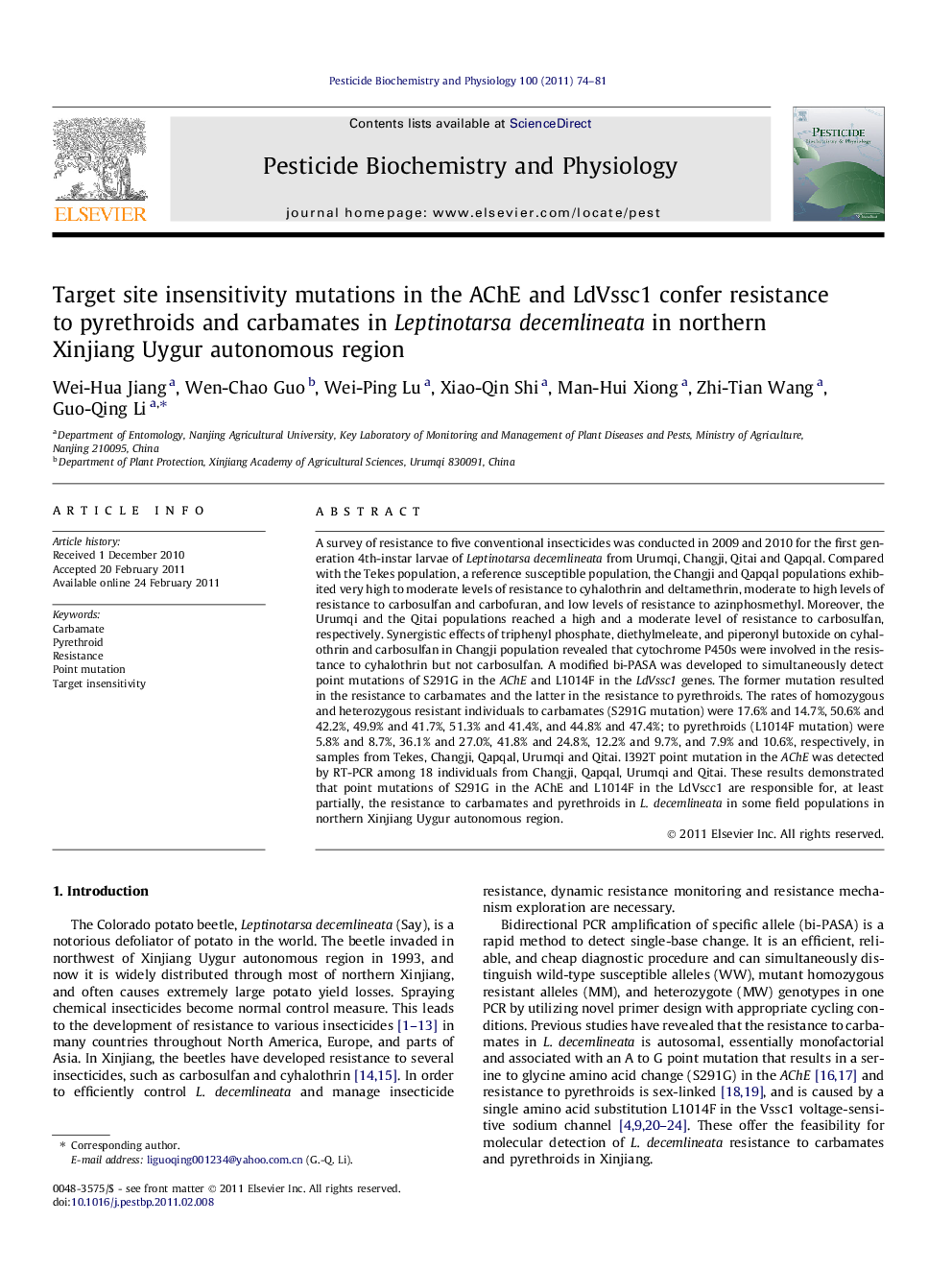| Article ID | Journal | Published Year | Pages | File Type |
|---|---|---|---|---|
| 2009772 | Pesticide Biochemistry and Physiology | 2011 | 8 Pages |
A survey of resistance to five conventional insecticides was conducted in 2009 and 2010 for the first generation 4th-instar larvae of Leptinotarsa decemlineata from Urumqi, Changji, Qitai and Qapqal. Compared with the Tekes population, a reference susceptible population, the Changji and Qapqal populations exhibited very high to moderate levels of resistance to cyhalothrin and deltamethrin, moderate to high levels of resistance to carbosulfan and carbofuran, and low levels of resistance to azinphosmethyl. Moreover, the Urumqi and the Qitai populations reached a high and a moderate level of resistance to carbosulfan, respectively. Synergistic effects of triphenyl phosphate, diethylmeleate, and piperonyl butoxide on cyhalothrin and carbosulfan in Changji population revealed that cytochrome P450s were involved in the resistance to cyhalothrin but not carbosulfan. A modified bi-PASA was developed to simultaneously detect point mutations of S291G in the AChE and L1014F in the LdVssc1 genes. The former mutation resulted in the resistance to carbamates and the latter in the resistance to pyrethroids. The rates of homozygous and heterozygous resistant individuals to carbamates (S291G mutation) were 17.6% and 14.7%, 50.6% and 42.2%, 49.9% and 41.7%, 51.3% and 41.4%, and 44.8% and 47.4%; to pyrethroids (L1014F mutation) were 5.8% and 8.7%, 36.1% and 27.0%, 41.8% and 24.8%, 12.2% and 9.7%, and 7.9% and 10.6%, respectively, in samples from Tekes, Changji, Qapqal, Urumqi and Qitai. I392T point mutation in the AChE was detected by RT-PCR among 18 individuals from Changji, Qapqal, Urumqi and Qitai. These results demonstrated that point mutations of S291G in the AChE and L1014F in the LdVscc1 are responsible for, at least partially, the resistance to carbamates and pyrethroids in L. decemlineata in some field populations in northern Xinjiang Uygur autonomous region.
Graphical abstractL. decemlineata 4th-instar larvae from Changji and Qapqal in Xinjiang exhibited resistance to cyhalothrin, deltamethrin, carbosulfan and carbofuran, from Urumqi and Qitai had resistance to carbosulfan. A modified bi-PASA was developed to simultaneously detect point mutations of S291G in AChE and L1014F in LdVssc1. The rates of homozygous and heterozygous resistant individuals to carbamates (S291G mutation) were 17.6% and 14.7%, 50.6% and 42.2%, 49.9% and 41.7%, 51.3% and 41.4%, and 44.8% and 47.4%; to pyrethroids (L1014F mutation) were 5.8% and 8.7%, 36.1% and 27.0%, 41.8% and 24.8%, 12.2% and 9.7%, and 7.9% and 10.6%, respectively, in samples from Tekes, Changji, Qapqal, Urumqi and Qitai. These demonstrate that point mutations of S291G in AChE and L1014F in LdVscc1 are responsible for, at least partially, the resistance to carbamates and pyrethroids.Figure optionsDownload full-size imageDownload as PowerPoint slideResearch highlights► L. decemlineata larvae from Xingjiang showed resistance to carbamates and pyrethroids. ► Cytochrome P450s were involved in the resistance to cyhalothrin but not carbosulfan. ► A bi-PASA was developed to simultaneously detect point mutations in AChE and LdVssc1. ► Point mutations of S291G in AChE and L1014F in LdVssc1 were found in field populations.
